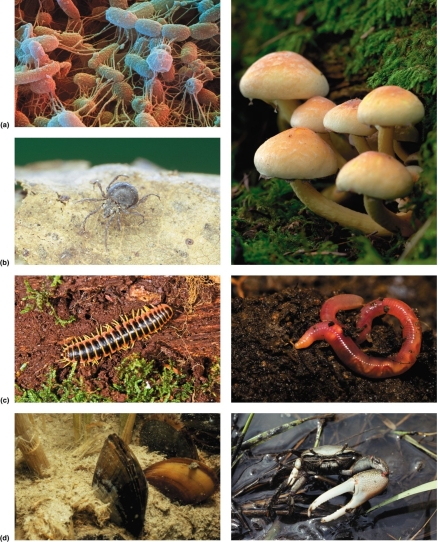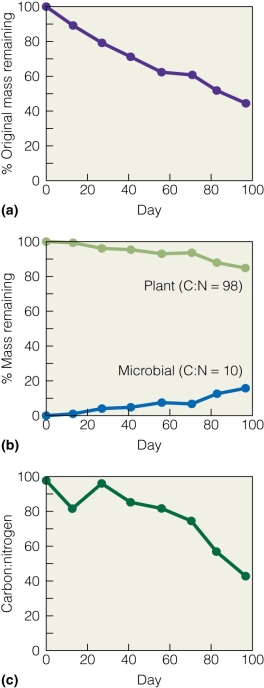A) forest canopy
B) photic zone
C) forest floor
D) kelp forest
Correct Answer

verified
Correct Answer
verified
True/False
Estuaries receive nutrients both from tides and from streams and rivers.
Correct Answer

verified
Correct Answer
verified
Multiple Choice
Why do areas with high NPP typically have a high rate of nutrient cycling?
A) High amounts of productivity increase the number of decomposers.
B) High amounts of productivity increase water production.
C) High amounts of productivity cause low net mineralization rates.
D) High amounts of productivity use low amounts of nutrients.
Correct Answer

verified
Correct Answer
verified
Multiple Choice
The rate of nutrient cycling in an ecosystem
A) depends only on the rate of photosynthesis.
B) depends only on the rate of decomposition.
C) does not depend on the rate of photosynthesis or the rate of decomposition.
D) depends on both the rate of photosynthesis and the rate of decomposition.
Correct Answer

verified
Correct Answer
verified
Short Answer
Litter degrades into a dark brown or black homogeneous organic matter known as ________.
Correct Answer

verified
Correct Answer
verified
Multiple Choice
 Which of the following are decomposers?
Which of the following are decomposers?
A) mushrooms
B) mites
C) millipedes
D) all of the above
Correct Answer

verified
Correct Answer
verified
Multiple Choice
The process of conversion of nutrients from an organic form into an inorganic form that plants can use is called
A) immobilization.
B) respiration.
C) transpiration.
D) mineralization.
Correct Answer

verified
Correct Answer
verified
Short Answer
Animals that feed on bacteria and fungi are called ________.
Correct Answer

verified
Correct Answer
verified
Multiple Choice
The salt marsh system is dominated by
A) carnivores.
B) herbivores.
C) secondary consumers.
D) decomposers.
Correct Answer

verified
Correct Answer
verified
Multiple Choice
In an estuary,the zone of maximum vertical difference in density of water layers is called the
A) thermocline.
B) pycnocline.
C) mixing zone.
D) hypolimnion.
Correct Answer

verified
Correct Answer
verified
Short Answer
In an estuary,the zone of maximum vertical difference in density is called a(n)________.
Correct Answer

verified
Correct Answer
verified
True/False
In salt marshes,only a small portion of primary production is consumed by herbivores.
Correct Answer

verified
Correct Answer
verified
True/False
In open-water ecosystems,turnover prevents the movement of nutrients between the bottom and surface layers.
Correct Answer

verified
Correct Answer
verified
True/False
A C/N ratio of 134:1 will usually lead to immobilization.
Correct Answer

verified
Correct Answer
verified
True/False
Decomposers are primarily autotrophs.
Correct Answer

verified
Correct Answer
verified
Multiple Choice
Which of the following are considered decomposer mesofauna?
A) bacteria
B) earthworms
C) millipedes
D) mites
Correct Answer

verified
Correct Answer
verified
Multiple Choice
Which of the following variables is the coefficient that estimates decomposition rate?
A) e
B) k
C) t
D) d
Correct Answer

verified
Correct Answer
verified
Multiple Choice
 Why does the C/N ratio decline over time?
Why does the C/N ratio decline over time?
A) Mass increases over time.
B) Mass is converted into microbes over time.
C) Mass is converted into plants over time.
D) More carbon is introduced into the system.
Correct Answer

verified
Correct Answer
verified
Multiple Choice
The rate of net primary productivity can be limited directly by the availability of
A) organic nutrients in the soil solution.
B) inorganic nutrients in the soil solution.
C) organic carbon in the soil solution.
D) inorganic carbon in the soil solution.
Correct Answer

verified
Correct Answer
verified
Short Answer
The breakdown of chemical bonds that were formed during the construction of plant and animal tissues is called ________.
Correct Answer

verified
Correct Answer
verified
Showing 21 - 40 of 64
Related Exams